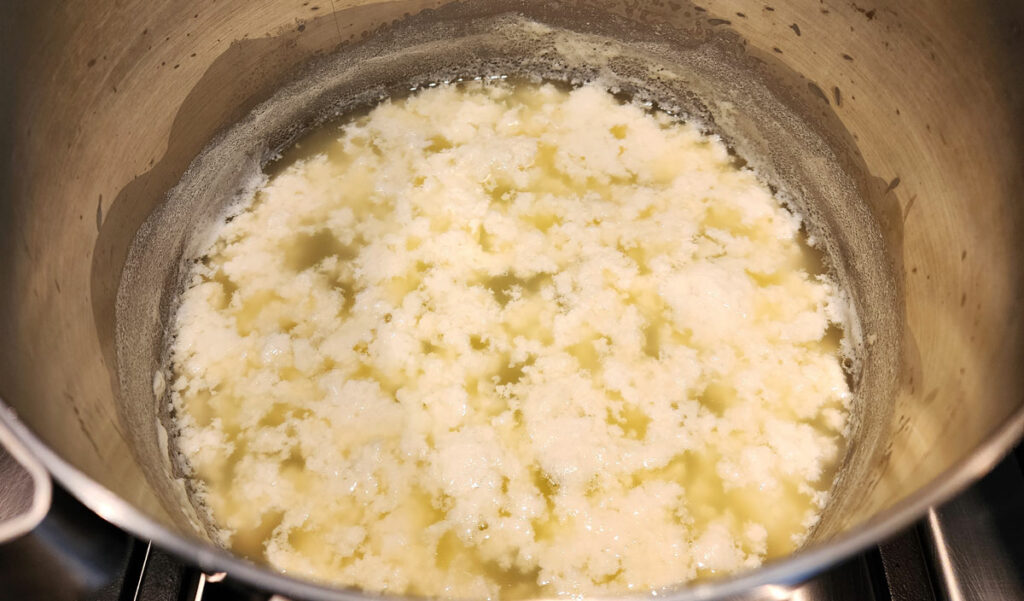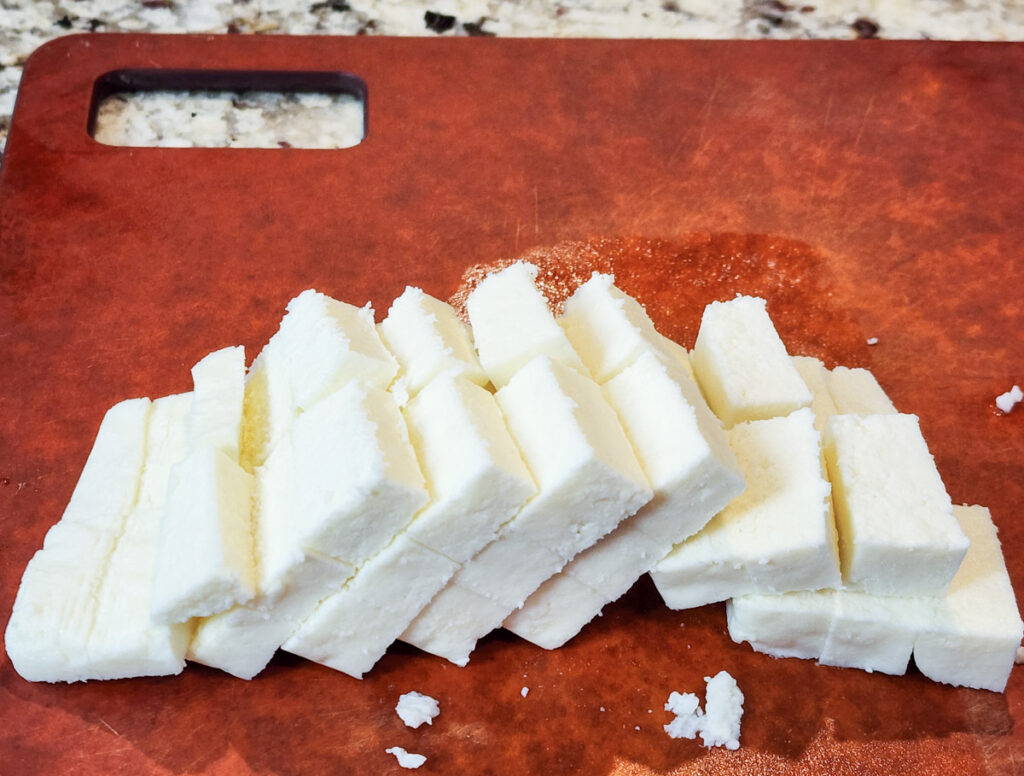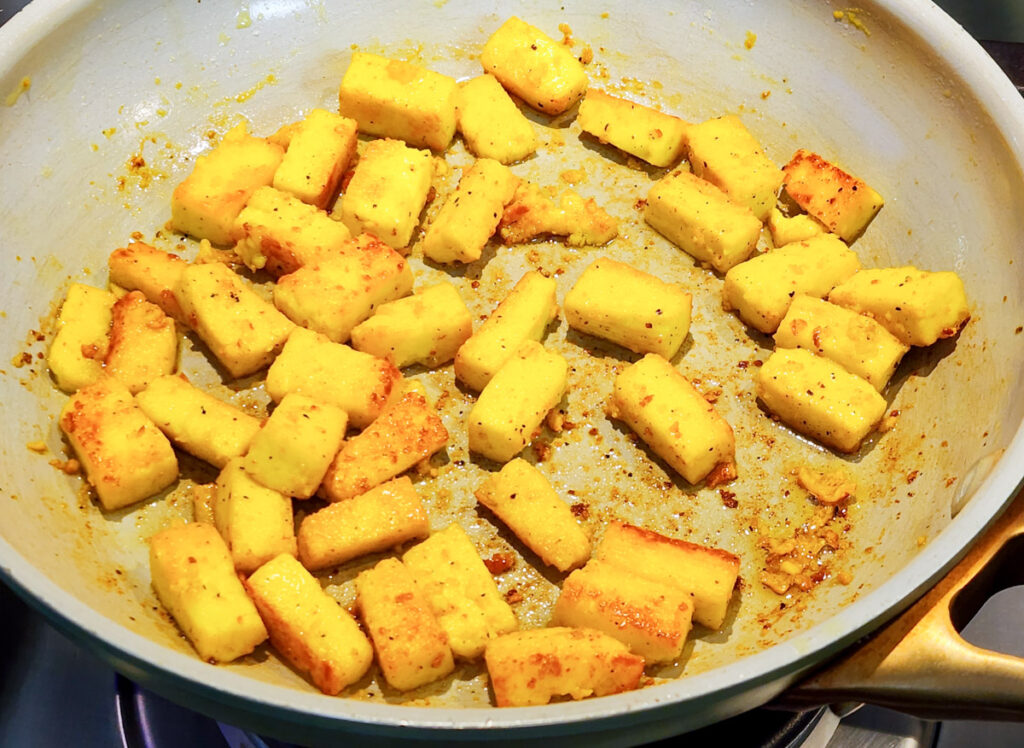This post may contain affiliate links. Please see our disclosure for more information.
Are you looking for an easy-to-digest vegetarian protein source that isn’t a legume, nut, or egg?
Look no further than paneer.
Jump to RecipePaneer is a simple unripened cheese made from whole milk.
When you fry it, or put it in stew, paneer keeps its shape, just like tofu.
Paneer’s texture is soft, and a little chewy. It’s so much better than tofu.
When you make paneer from scratch using good quality milk, it’s going to literally melt in your mouth. Very satisfying indeed!
Making paneer is simple, and takes less than 30 minutes. There is additional time for the paneer rest, but you’re not working, so we aren’t counting that.

All you need to do it heat the milk, then curdle it with lemon juice to reveal curds and whey.
After you press the cheese curds, you’ll have paneer.
Equipment needed
- a large saucepan to heat the milk
- cheesecloth
- a sieve to strain the curds
- a plate and something heavy (like jars of food) to press the curds
Health benefits
Paneer is a highly concentrated source of calories, fat, and protein.
It’s perfect if you are trying to gain weight, or you are looking for an alternative to meat.
Paneer is a source of minerals that support healthy bones and teeth (calcium, magnesium and phosphorus), as well as conjugated linoleic acid, which promotes muscle tissue, and increases the body’s capacity to burn fat.
A 1-ounce portion of paneer contains:
- 85 calories
- 0.8 grams carbohydrate
- 5.1 grams protein
- 6.8 grams fat
Paneer is significantly higher in calories and fat than lean meat, so you definitely want to be mindful about your portions. About 1 ounce is a good portion size.
Why paneer?
Ayurveda views milk, and certain milk products, very favorably as an important source of animal protein for vegetarians.
About 1/3 of India’s population is vegetarian, and you can bet they consume dairy to maintain overall health.
If you are vegetarian, or trying to cut down on your meat consumption, then paneer is an excellent source of animal protein and healthy fats.
This is true particularly for women who are concerned about maintaining healthy bones and muscles.
Since paneer is so easy to digest, it’s also good for children, the elderly, or those with sensitive tummies.

What about the fat?
Full-fat dairy is considered to be a healthy fat.
One of the reasons is that the fat, protein, and natural sugars contained in full-fat dairy are balanced in a way that supports metabolism – a.k.a. straight from nature.
When fat is stripped out of dairy to make low-fat products, sugar, gelatin, and other unhealthy ingredients are often used as replacements.
What about the cholesterol?
Although full fat dairy contains LDL cholesterol, it also contains the good cholesterol.
It’s important to remember that not all cholesterol is the enemy.
According to Dr. Marianne Teitelbaum, who is my guru on many things Ayurveda, it’s actually the artery clogging nature of certain foods that contain cholesterol that we need to watch out for.
Among the foods to avoid are red meat, sausage, bacon, and aged hard cheeses, as well as nut butters, tofu, soy milk, edamame, and vegetable oils like sunflower, canola, peanut, and margarine.
The foods with cholesterol that won’t clog your arteries are ghee, un-homogenized boiled milk, soft cheeses like paneer, ricotta, fresh mozzarella, and cottage cheese, as well as chicken, turkey, fish, lamb, and goat.
She also says it is important to take care of the liver and gallbladder, since these organs help to clear cholesterol out of the blood.
Another way of saying this is that you need to digestive strength to metabolize the paneer so it doesn’t get stuck in the digestive tract and create toxins.
Body types and paneer
As for the Ayurvedic body types, paneer is going to be the best for Vata types and the fall and early winter seasons, due to the heavy, nourishing, and gooey qualities of paneer.
Pitta types will benefit from the heavy quality, and the satisfaction from the protein and fat.
Kapha types should consume paneer in smaller quantities to avoid aggravation.
Always make sure you have strong hunger when consuming paneer to ensure that you are fully metabolizing all of its nutrition.
Cooking with paneer
Paneer is a relatively rich item, so you need only a little for a serving. I recommend 1 ounce, or about the size of a small lemon.

The easiest way to cook paneer is going to be sautéing cubes of it in ghee with a pinch of spice, such as turmeric and black pepper.
You could also crumble or grate it, and fry it like scrambled eggs. Add in some vegetables like red bell pepper and green onions, and enjoy it toast or in a wrap.
You can also explore my recipe for paneer tikka masala, which is the vegetarian version of the most popular Indian dish in the world.
Paneer is also really easy to add to soups and stews, such as this vegetable stew with protein.
What milk do I use?
You can use any whole milk to make paneer, but the best milk to use is raw or unhomogenized whole milk from grass-fed cows.
Finding unhomogenized milk is the most important thing, because the process of homogenization changes the chemical structure of the milk, making it very difficult to digest.
You might need to search in your area to find a source for unhomogenized or raw milk. If you look, I expect you will be rewarded.
In my area, I get unhomogenized milk delivered to my door from a local distributor. It’s the cream top variety.
It isn’t organic or necessarily grass-fed all the time. That’s not even possible in New York State. When appropriate, they do allow their cows to graze on their 1000+ acres, and they grow their own cattle feed.
Mine is also a dairy that produces and bottles its own milk. They go from milking to bottling is 8 hours. You would refer to this as a single-source dairy.
A single-source dairy is very rare.
Most milk on grocery store shelves represents an amalgamation of dozens of dairy farms. The milk travels from the farms to the processing facility before its bottled and distributed. An aggregate milk increases the bacterial count in the milk dramatically.
So the moral of this story is that you need to learn about the famers that produce your milk, and then it will give you peace of mind.
If you can’t find unhomogenized milk, the next best thing is whole milk from a local dairy or farm coop. Organic and/or grass-fed is a bonus.
Watch out for the national brands that sell organic and grass-fed. They aren’t as good as local companies.
Can I just buy paneer?
If you want to buy paneer first to try it out, I highly recommend Haldiram’s brand.
To get it, you’ll likely have to visit the refrigerated section of an Indian store.
You may also find paneer are natural foods or specialty stores.
Homemade Paneer in 30 Minutes or Less
Equipment
- Large stainless steel saucepan with lid
- sieve or colander
Ingredients
- 4 cups whole milk
- 2 tablespoons lemon juice
Instructions
Heat the milk, then curdle it
- Pour the milk into a large heavy-bottomed saucepan. Bring the milk to a boil on medium-high heat. Stir often to prevent sticking and scorching. Be patient, and resist the urge to turn up the heat. This could cause the milk to burn, or boil over.
- When you get to the stage where the milk is coming to a boil and it’s fully foaming, turn down the heat to low. Before the foam subsides, add the fresh lemon juice. Move your spoon through the milk in one direction, then the other, for about 20 second. Move gently and slowly.
- Turn off the heat and continue to gently agitate with the spoon until soft curds form. If the curds have not formed within 1 minute, return the pan to the heat, or add a bit more lemon juice.
- As soon as the cheese curds have formed, cover, and let it sit for 10 minutes. When the cheese has settled under the surface of the whey, it is ready to drain.
Collect the cheese curds
- Set a sieve over a large bowl and place a large piece of cheesecloth in the sieve. Gently pour the curds from the pot into the cheesecloth.
- Pour a gentle stream of lukewarm tap water over the curds to rinse off the lemon juice.
- Gather up the corners of the cheesecloth and twist gently to press the curds together and drain the water. Be firm, but do not over squeeze.
Press the cheese curds
- Open up the cheesecloth on your cutting board to reveal your beautiful ball of unpressed cheese curds. Wrap the ball up in the cloth, then press it down with your hands to form a block.
- Transfer the paneer to a plate. The plate will catch any water that drains out in this next step. Cover with another plate, and find something heavy to place on top to press the paneer. Canned food works well for weights. Press it for 20 minutes or longer.
